Rules
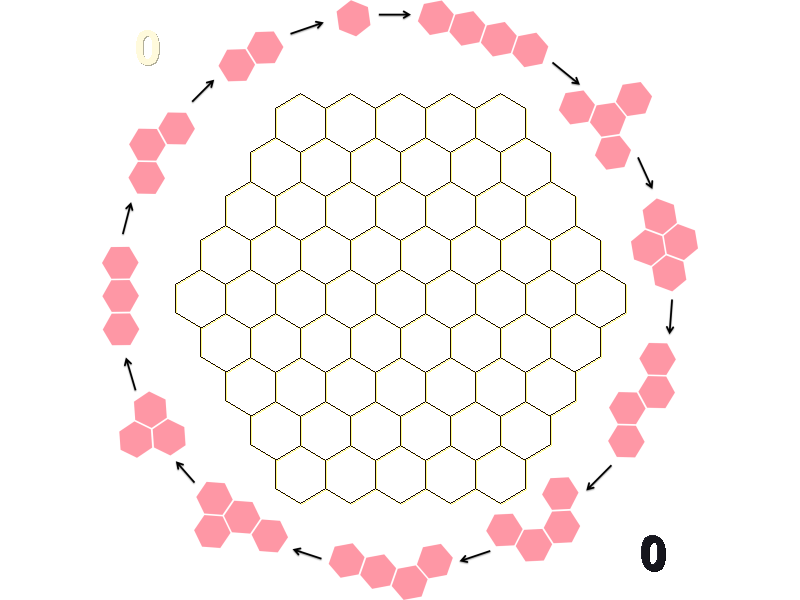
Representative game (in the sense of being of mean length). Wherever you see the 'representative game' referred to in later sections, this is it!
Place a piece in any empty piece, then eat everything that can be eaten
Eat adjacent creatures of smaller size. Capture 20 stones to win, or stalemate your opponent.
Generated at 02/08/2021, 22:19 from 1000 logged games.

Representative game (in the sense of being of mean length). Wherever you see the 'representative game' referred to in later sections, this is it!
Place a piece in any empty piece, then eat everything that can be eaten
General comments:
Play: Combinatorial,Themed
Mechanism(s): Pattern,Capture,Stalemate,Territory
Components: Board
| BGG Entry | Circle of Life |
|---|---|
| BGG Rating | 6.75639 |
| #Voters | 133 |
| SD | 1.49999 |
| BGG Weight | 2 |
| #Voters | 3 |
| Year | 2015 |
| User | Rating | Comment |
|---|---|---|
| yakshto | 8 | |
| Starkriller | 6 | |
| ChrisSmith4773 | 8 | |
| mrraow | 9 | The most original game I have played in the past year; though I'm not sure I'd like to play without computer moderation, because the chance of making an error is quite high. I like the emergent feeling of predation and struggle for territory. |
| 1974vertigo2009 | N/A | PnP - 983 |
| fogus | 6.1 | Preliminary rating: An odd abstract strategy game that is very opaque despite the inclusion of a wheel of death. |
| switza | 6 | |
| mirror33 | 6 | |
| ChameleonBG | 6 | |
| dexdouglas | 8 | |
| HanneLiev | N/A | Eens bekijken |
| yaron | 6 | |
| vttdavid9 | 7 | |
| Parkersburg | 8 | |
| Hensanson | 8 | |
| josephfeller | 7 | Played on BGA. |
| grolapinos | 9 | |
| shinnosuke | 6 | |
| schwarzspecht | 8 | |
| enavico | 5 | + Quite interesting abstract - First player advantage? |
| Sqrt2 | N/A | DIY. |
| kefer9 | 7 | |
| Wentu | 8.7 | This game is amazing! I haven't played dozens of games but the few experiences I am having are unbelievably tense and full of surprises! the best abstract I have seen in a long time (let's say since Santorini). When there will be a good physical implementation I could raise this yet again. ------------------------------ [EDIT] This game is a blast! it has a clear plausible reference to a theme I adore, it requires tactics (a lot!!) and some strategy, a lor of pattern recognition and a good dose of evil. Extremely entertaining. -------------------------------- [EDIT] never played it, but the idea is great and I like it a lot. I wonder: does the order of feeding must really be fixed or could it be conceivable to have it changing for each game? |
| hawk-x- | 8 | Wow. This abstract is pretty boss. It's engrossing, wildly different, and has a theme that actually works as a theme? |
| bcnevan | 4 | The theming generally works, if a little forced. Your placements evoke some indications of evolution, competition, and an ecosystem, all of which are framed around the piece capture circle. Leaning into its abstract nature via unlabeled critters helps the indications emerge. But the game's thematic expression also seems to lack something impactful, like the pile of dead from Guerrilla Checkers. Giving labels to the critters might help give the game some explicit narrative that could be impactful (our ecosystem at game end included species a, b, and c), but would likely make the evolution part of the theme farcical. The first few games are spent looking as much at the hard-coded circle as the board, and that doesn't make for particularly enjoyable player on-boarding. I'm not sure that particularly matters, as it does force the players to make an effort to connecting with the themes. The board play is defined by restriction and look-forward rock, paper, scissors. For example, the first player places the first piece at the board's center and now the second player is disinclined to place within 2 hexes of that piece, lest that piece be captured by the first player and board presence becomes even more unequal. So, pieces are spread over the especially small board and then the game becomes about forcing your opponent into certain moves until enough of the initial board control is upheaved. The early game is incredibly unengaging. I'd rather seed the board with an initial ecosystem than go through the early part again and again. |
| MusRattus | 7 | |
| ankeszu | 9.1 | |
| liefde_is | 8 | like to play it at BGA |
| Bonzarello | 8 | |
| M2Cat | 8 | |
| gmcnish | N/A | Diy yavalath board and go stones |
| gmg159 | 7 | |
| eusebio_babilon | 7.6 | |
| djgold | 10 | |
| patoloko | 8 | |
| eggpie | 7.5 | |
| grasa_total | 5 | One play, still learning the dynamics. Secretly a game of territory capture, not piece capture, with logic puzzles around defense. Would like it more if the 'circle of life' was small or orderly enough to learn by heart quickly, but that may be an unavoidable downside of the design. [Played in homemade version from web rulebook, no version number.] |
| ceenan | 7 | |
| Zzz77 | 6 | |
| Baggyboo | 7 | |
| lulu35 | N/A | BGA |
| bugTrap | N/A | BGA online version. 1 play. Neat abstract. Would love to play this one again. |
| biofarmspineto | 10 | |
| komacchin | 10 | |
| andiex | 6.5 | |
| melendor | 7.5 | |
| flahr | 9 | |
| Tr0llet | 7 | |
| MARIANOJS | 6 | |
| Astramance | 7 | |
| BankofDracula | 9 | |
| Rontuaru | 6 | I liked this quite a bit, with the potential for a rise in rating should I chance at more plays. As it stands, it's a tremendously creative and elegant design of feints and actions and reactions and multiple-compromises, with a permeating tension throughout. A qualm, if any, is that it can plod at times when players are assessing the food chain priority. |
| zevtrantor | 8 | |
| CyBear | 9 | DIY? |
| conorchinitz | 8 | |
| mirth00 | 6 | |
| Nievares | 8 | |
| squiffles | 8 | |
| cannis123 | 6 | |
| Another_Dead_Hero | 6 | |
| pwoloszun | 7 | Initial rating after just 2 plays. Clever abstract which is really thematic |
| semaphores | 7 | |
| Rakasis | 7.6 | ~ |
| megamau | 7 | |
| thenexusgame | 9 | |
| thierryhavard | 8 | |
| maruXV | 7 | |
| Stick59 | 7 | |
| Marc_D | 6 | |
| ryansdavis | 6 | |
| nipplegoblin | 7 | |
| vialiy | 8 | |
| luigi87 | 8 | |
| aclif | 8 | Unique abstract strategy. Easy to learn. Hard to master |
| Truthsketcher | 6 | Fun and simple abstract PnP game. Worth playing. |
| RustedTree | N/A | For future reference: streamlined abstract with polyhexes and innate powers. Super interesting, want to print it and play. |
| js3b | 8 | |
| Hartyfarty | 7 | |
| orangeblood | 6 | I love most of Nick's games, but this one doesn't quite click for me. I view Bug as a similar but much superior “grow and eat” game, perhaps because the eating chain in CoL does not fire the same creative feelings in me. I also don’t like needing to look back at the chart to see who eats whom, even though I know it would come more naturally to me with more plays. |
| Joseph Hill | 8 | |
| hojoh | N/A | https://docs.google.com/document/d/1B8TIPKEC5dqOFLinVsqDfKxA6Nr0u4ialSUCBtlZhPA/edit?usp=sharing |
| microbio007 | N/A | PnP |
| aswegler0606 | 7.9 | smartly crafted 2 player abstract. got a chance to playtest this and was very impressed with the balance and foresight put into the design. can't wait to play again! |
| evanvariano | N/A | My family loves Evolution, the beginning, which the designer (Nick Bentley) was involved with. And I love Nick's dedication to the simplest possible rulesets. I don't think I'll log a lot of plays on this because I expect I'll need to return to the cheat sheet constantly. Unless I can figure out some mnemonic whereby each shape is a known species. |
| twerkface | N/A | On Ai Ai |
| dispatch134711 | 8.6 | I will never not try a Nick B. game given half a chance. While necessarily not as elegant / minimalist as Catchup, given the rules of predation, Carnivores has a simple yet visceral mechanism that really gives you the feeling of evolving and then viciously consuming various beasts in constantly shifting rock-paper-scissor type matchups. Am still struggling to beat the AiAi bot, every time I think I'm winning I realise I am overcommitting to large shapes/ structures. Rule query - it seems if a piece makes a capture and a suicide, capture prevails and the creature does not commit suicide. Maybe you could message me to confirm, Nick. FWIW, here's my mnemonic for remembering who eats who - 2 piece eats singleton crooked 3 eats 2 straight 2 beats crooked 'clump' beats straight axe breaks clump snake outmaneuvers axe horse eats snake bug annoys horse boomerang takes out bug (?) ninja star is cooler than boomerang staff (4 straight) is strongest, meaning by necessity, singleton beats staff, making it a dubious play at best. |
| sjkat17 | 8 | |
| Nathardicus | 6 | An interesting abstract game. I like that the shapes evolve over time but eventually hit a maximum value. I also like that due to the shapes on the board some spaces are blocked to one side but can be vital to the other side getting the edge. It's also fun when a surprising shape change turns the prey into a predator. The play does tend to go in circles and that does become boring after a while. It's a good one to play for a bit and then move on. |
| tiagoVIP | 6 | Designer: Nick Bentley Playing time: 20-40 Min Weight: 2.00 / 5 Publisher: (Web published) [b]COMPLEXITY: Medium COMPONENTS: N/A DOWNTIME: Medium FUN: Low INTERACTION: High PLAYING TIME: Medium LUCK : Very low REPLAY VALUE: High SOLITAIRE: Very low THEMATIC: Very Low[/b] [b]Comments:[/b] [thing=184730][/thing] is an abstract strategy game, based ecosystems, with the food chain, evolution, domination and so on (but is still abstract). It is a very thinky game about positioning your pieces for make forms, both to protect them from those made by your opponents, as well as to try to "eat" the ones he makes. There is chain that shows which form will eat the other, in a full circle. Thus you can protect your pieces by changing the form of them (but only up to a form that uses 4 pieces), but at some point you either let go, or start a new battle of shapes somewhere else. Each piece captured in a shape that was eaten counts as 1 point, and the first person to 20 points (or 30, for a long game) will be the winner. There is a surprising amount of possibilities and room for blocking, preparing and smart plays. Attention and planning ahead is key to do well: [thing=184730][/thing] is the sort of game players will be looking, silent, hands on chins, calculating placement of pieces and how to best make your moves without actually helping the other side, until often one player goes: "Oh, crap", after doing an action that gave the game to the opponent, or the adversary did a move that you won't be able to stop him from winning in his next turn. Even more to me, as I had a pretty hard time to being able to look for the patterns, and how to place my pieces in a advantageous manner. Haven't felt so lost since Ricochet Robots! Overall, [thing=184730][/thing] isn't close to my heart - I don't like much these analytical abstract games, as I much prefer deep themes with some random factors, to add surprises, tension and emotion. Still, this will often be an fun experience for those that like the GIPF series and enjoy a battle of brains in a controlled environment. |
| ericbinnyc | 6 | Deceptively tricky hex-based perfect information abstract game. |
| iMisut | 8 | |
| AmassGames | 8 | Great game after only 3 moves! BGA |
| man_online | 7.5 | |
| MrCoCheese | 5 | BGA |
| arimarima | 8 | After a few plays, seems very solid. The 'circle of life' is a very interesting idea, if a little difficult to get my head around. It's a lot harder than standard paper, scissors, rock. Enough here though to keep me interested while i work out some kind of strategy. |
| mschlat | 8 | |
| poggydude | 7 | |
| javinoa | N/A | DIY |
| Parkersaurus | 10 | |
| benpulver43 | 6 | |
| rseater | 4 | Turn based rock-paper-scissors. This game hurts my head -- it is very tactical and thinking ahead careful is extremely important. Not very heuristic. The pattern of captures among size-4 patterns seems a bit arbitrary, but there may be a deeper justification. If it really is arbitrary, I wonder what would happen if that part became a modular setup element. There seems to be a big first player, advantage, but I'm not sure. Pie rule may be needed. Overall, the game is quite clever but not my cup of tea. |
| NoLuckAndNoSkill | 6 | |
| EllieK | 6 | Tip-top abstract. Engaging and most importantly, fun. All the fun of Tash-Kalar extracted into a simple, back and forth, give and take game. |
| PiGuy | 10 | Excellent abstract game with easy rules and amazing depth! |
| tkvaran | 8 | |
| PabloNevoeiro | 8 | |
| ProZD | 7 | |
| Iguanoman | 7 | |
| holf | 6.2 | 在有限的棋盤上擺放環環相剋的棋子型態,不是太容易玩~ |
| davetompkins | 7 | |
| bluebee2 | N/A | PnP |
| aseemrb | 7 | |
| slimy_asparagus | 8 | Print and play - amazingly deep but fairly quick game. |
| rocksnrolls | 6 | |
| benme | 7 | Played 2 times on BGA and will play again and that in itself is pretty promising. In a vast world of abstracts there is nothing really like this. With such simple rules that is an acheivement. I have a few reservations - it can be hard to track what beats what in your head. The visual aide around the board really helps but it still can lead to moments of ...oh I didnt think that would happen. This type of stuff is true in many games though e.g. chess you can move so the opponent can capture you. it takes a few plays to stop that happening. The second reservation is the second win condition being who cannot move first wins. neither of us could quite see how to influence that meaningfully. That might go away with more plays but it did lead to our second game finishing in a slightly flat and anticlimatic way. But we both want to play it again so that puts it ahead of many abstracts. |
| pezpimp | 6 | Based on one play: Like Nick Bentley's other game, I like the idea and when reading the rules it seems interesting, however it loses a little during game play. Each piece can only eat a specific other piece and it is hard to counter an opponent as once you hit a four piece critter, as you cannot really defend. Still a fun game with a nice little theme. |
| AndrewLSmith84 | 7 | |
| CHRISDH | 6 | *6* (Initial plays) Not totally sure how I feel about this yet. It’s interesting and has more to think about than what’s in the surface. |
| heggahegga | N/A | 2 Player |
| Size (bytes) | 30976 |
|---|---|
| Reference Size | 10293 |
| Ratio | 3.01 |
Ai Ai calculates the size of the implementation, and compares it to the Ai Ai implementation of the simplest possible game (which just fills the board). Note that this estimate may include some graphics and heuristics code as well as the game logic. See the wikipedia entry for more details.
| Playouts per second | 7465.90 (133.94µs/playout) |
|---|---|
| Reference Size | 573328.75 (1.74µs/playout) |
| Ratio (low is good) | 76.79 |
Tavener complexity: the heat generated by playing every possible instance of a game with a perfectly efficient programme. Since this is not possible to calculate, Ai Ai calculates the number of random playouts per second and compares it to the fastest non-trivial Ai Ai game (Connect 4). This ratio gives a practical indication of how complex the game is. Combine this with the computational state space, and you can get an idea of how strong the default (MCTS-based) AI will be.

% new positions/bucket
| State Space Complexity | 48412063 | |
|---|---|---|
| State Space Complexity (log 10) | 7.68 | |
| Confidence | 51.57 | 0: totally unreliable, 100: perfect |
| Samples | 830166 |
State space complexity (where present) is an estimate of the number of distinct game tree reachable through actual play. Over a series of random games, Ai Ai checks each position to see if it is new, or a repeat of a previous position and keeps a total for each game. As the number of games increase, the quantity of new positions seen per game decreases. These games are then partitioned into a number of buckets, and if certain conditions are met, Ai Ai treats the number in each bucket as the start of a strictly decreasing geometric sequence and sums it to estimate the total state space. The accuracy is calculated as 1-[end bucket count]/[starting bucklet count]
| Label | Its/s | SD | Nodes/s | SD | Game length | SD |
|---|---|---|---|---|---|---|
| Random playout | 8,656 | 101 | 536,174 | 6,206 | 62 | 7 |
| search.UCT | 8,749 | 206 | 66 | 9 |
Random: 10 second warmup for the hotspot compiler. 100 trials of 1000ms each.
Other: 100 playouts, means calculated over the first 5 moves only to avoid distortion due to speedup at end of game.
Rotation (Half turn) lost each game as expected.
Reflection (X axis) lost each game as expected.
Reflection (Y axis) lost each game as expected.
Copy last move lost each game as expected.
Mirroring strategies attempt to copy the previous move. On first move, they will attempt to play in the centre. If neither of these are possible, they will pick a random move. Each entry represents a different form of copying; direct copy, reflection in either the X or Y axis, half-turn rotation.
| 1: White win % | 47.70±3.08 | Includes draws = 50% |
|---|---|---|
| 2: Black win % | 52.30±3.10 | Includes draws = 50% |
| Draw % | 0.00 | Percentage of games where all players draw. |
| Decisive % | 100.00 | Percentage of games with a single winner. |
| Samples | 1000 | Quantity of logged games played |
Note: that win/loss statistics may vary depending on thinking time (horizon effect, etc.), bad heuristics, bugs, and other factors, so should be taken with a pinch of salt. (Given perfect play, any game of pure skill will always end in the same result.)
Note: Ai Ai differentiates between states where all players draw or win or lose; this is mostly to support cooperative games.
| Match | AI | Strong Wins | Draws | Strong Losses | #Games | Strong Score | p1 Win% | Draw% | p2 Win% | Game Length |
|---|---|---|---|---|---|---|---|---|---|---|
| 0 | Random | |||||||||
| 1 | UCT (its=2) | 631 | 0 | 346 | 977 | 0.6153 <= 0.6459 <= 0.6752 | 52.00 | 0.00 | 48.00 | 62.68 |
| 4 | UCT (its=5) | 631 | 0 | 328 | 959 | 0.6274 <= 0.6580 <= 0.6873 | 50.99 | 0.00 | 49.01 | 63.74 |
| 12 | UCT (its=13) | 631 | 0 | 359 | 990 | 0.6069 <= 0.6374 <= 0.6667 | 47.88 | 0.00 | 52.12 | 66.64 |
| 24 | UCT (its=25) | 631 | 0 | 359 | 990 | 0.6069 <= 0.6374 <= 0.6667 | 49.70 | 0.00 | 50.30 | 68.59 |
| 40 | UCT (its=41) | 631 | 0 | 347 | 978 | 0.6147 <= 0.6452 <= 0.6746 | 48.06 | 0.00 | 51.94 | 69.80 |
| 45 | UCT (its=46) | 521 | 0 | 479 | 1000 | 0.4900 <= 0.5210 <= 0.5518 | 48.90 | 0.00 | 51.10 | 70.11 |
| 46 | UCT (its=46) | 502 | 0 | 498 | 1000 | 0.4711 <= 0.5020 <= 0.5329 | 47.60 | 0.00 | 52.40 | 70.62 |
Search for levels ended: time limit reached.
Level of Play: Strong beats Weak 60% of the time (lower bound with 95% confidence).
Draw%, p1 win% and game length may give some indication of trends as AI strength increases.

This chart shows the win(green)/draw(black)/loss(red) percentages, as UCT play strength increases. Note that for most games, the top playing strength show here will be distinctly below human standard.
| Game length | 67.43 | |
|---|---|---|
| Branching factor | 31.76 | |
| Complexity | 10^94.40 | Based on game length and branching factor |
| Samples | 1000 | Quantity of logged games played |
Computational complexity (where present) is an estimate of the game tree reachable through actual play. For each game in turn, Ai Ai marks the positions reached in a hashtable, then counts the number of new moves added to the table. Once all moves are applied, it treats this sequence as a geometric progression and calculates the sum as n-> infinity.
| Board Size | 61 | Quantity of distinct board cells |
|---|---|---|
| Distinct actions | 62 | Quantity of distinct moves (e.g. "e4") regardless of position in game tree |
| Good moves | 30 | A good move is selected by the AI more than the average |
| Bad moves | 31 | A bad move is selected by the AI less than the average |
| Response distance% | 47.64% | Distance from move to response / maximum board distance; a low value suggests a game is tactical rather than strategic. |
| Samples | 1000 | Quantity of logged games played |
A mean of 78.31% of board locations were used per game.
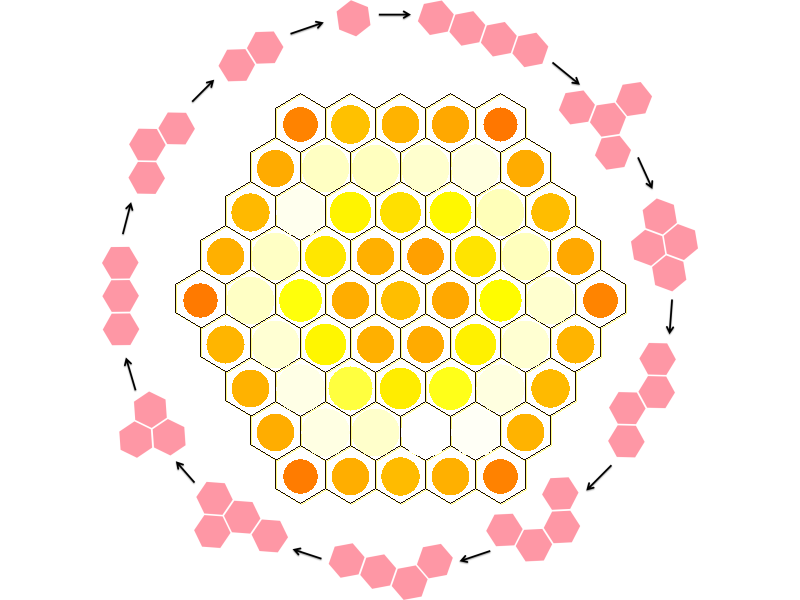
Colour and size show the frequency of visits.

Game length frequencies.
| Mean | 67.43 |
|---|---|
| Mode | [62] |
| Median | 67.0 |

| Mean change in material/round | 0.66 | Complete round of play (all players) |
|---|
This chart is based on a single representative* playout, and gives a feel for the change in material over the course of a game. (* Representative in the sense that it is close to the mean length.)

Table: branching factor per turn, based on a single representative* game. (* Representative in the sense that it is close to the mean game length.)

This chart is based on a single representative* game, and gives a feel for the types of moves available throughout that game. (* Representative in the sense that it is close to the mean game length.)
Red: removal, Black: move, Blue: Add, Grey: pass, Purple: swap sides, Brown: other.
| Moves | Animation |
|---|---|
| f5,c7,i4 |  |
| c9,g2,h5 | 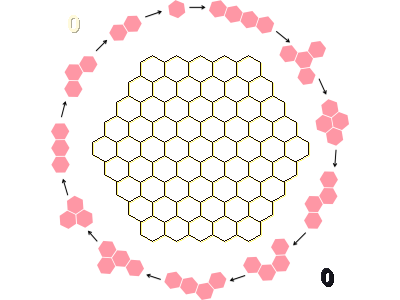 |
| c3,d7,b6 | 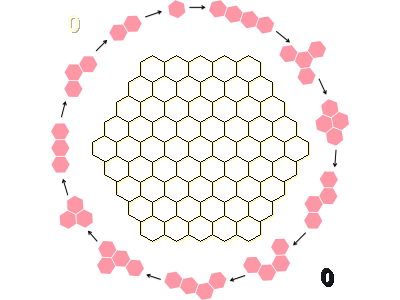 |
| a7,g6,c5 | 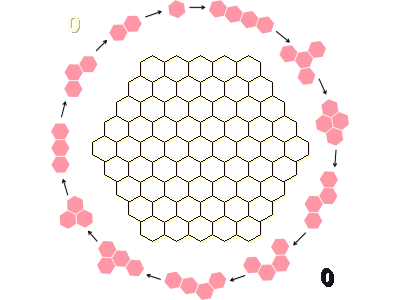 |
| d8,e7,e3 | 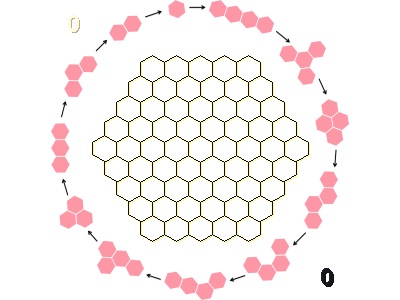 |
| e5,f8,g2 | 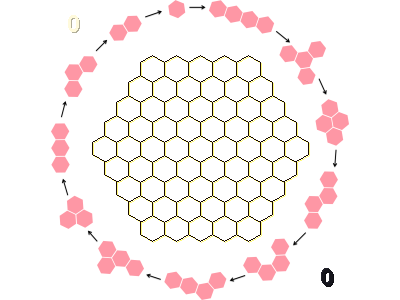 |
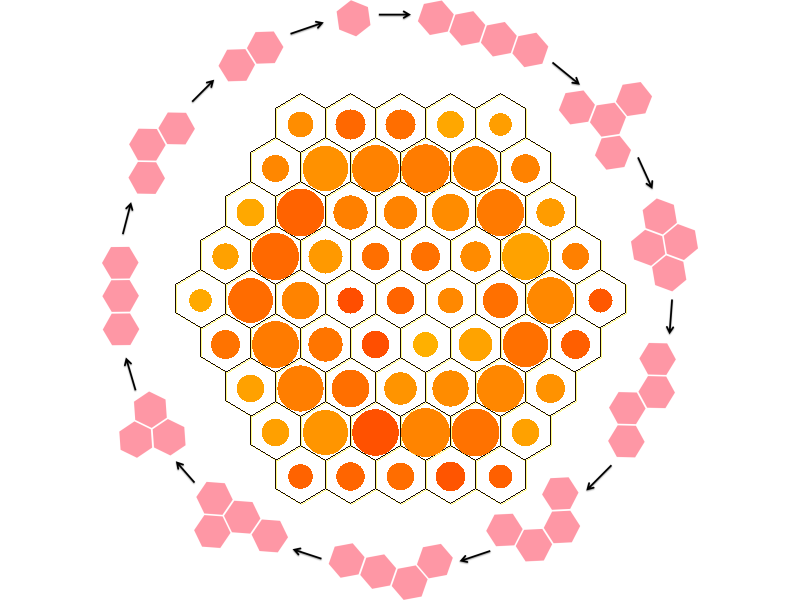
Colour shows the success ratio of this play over the first 10moves; black < red < yellow < white.
Size shows the frequency this move is played.
| 0 | 1 | 2 | 3 | 4 |
|---|---|---|---|---|
| 1 | 61 | 3721 | 110773 | 3200569 |
Note: most games do not take board rotation and reflection into consideration.
Multi-part turns could be treated as the same or different depth depending on the implementation.
Counts to depth N include all moves reachable at lower depths.
Inaccuracies may also exist due to hash collisions, but Ai Ai uses 64-bit hashes so these will be a very small fraction of a percentage point.
No solutions found to depth 4.
| Puzzle | Solution |
|---|---|
 Black to win in 9 moves | |
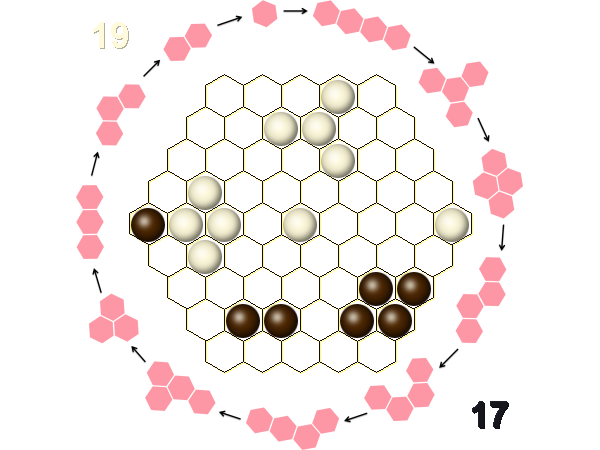 Black to win in 3 moves | |
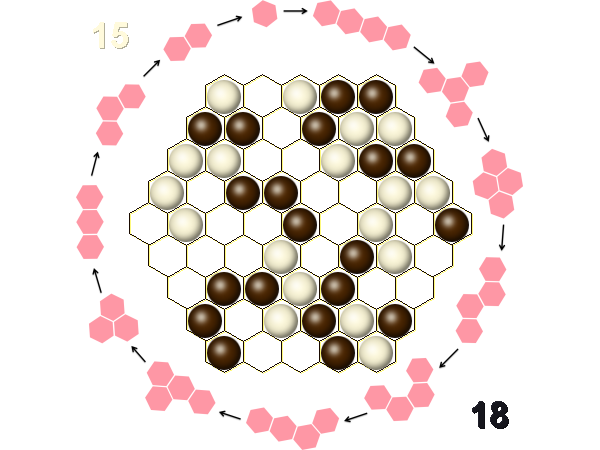 Black to win in 7 moves | |
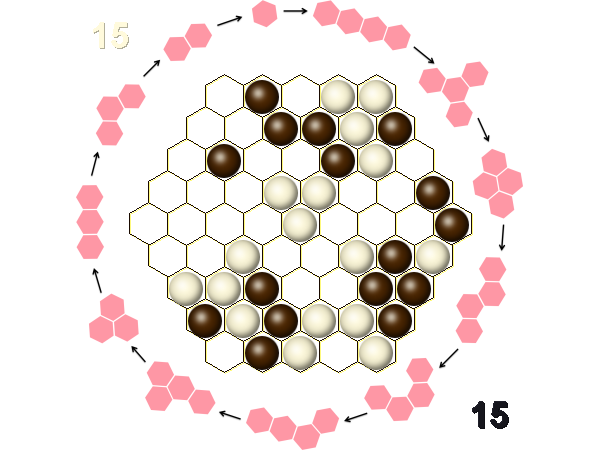 Black to win in 6 moves | |
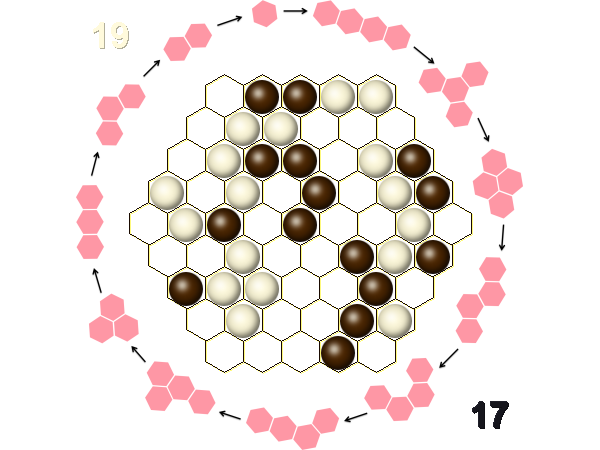 White to win in 9 moves | |
 White to win in 13 moves | |
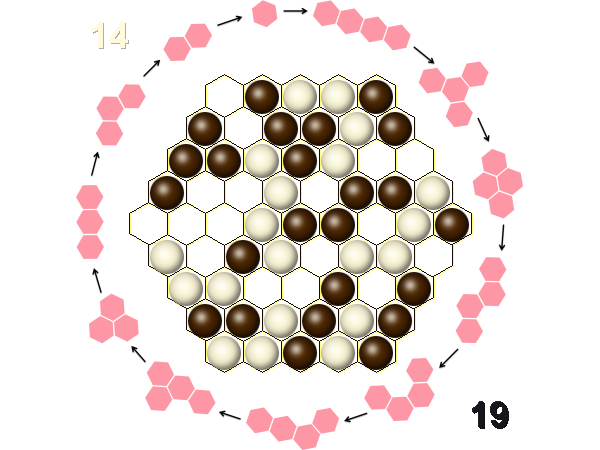 Black to win in 5 moves | |
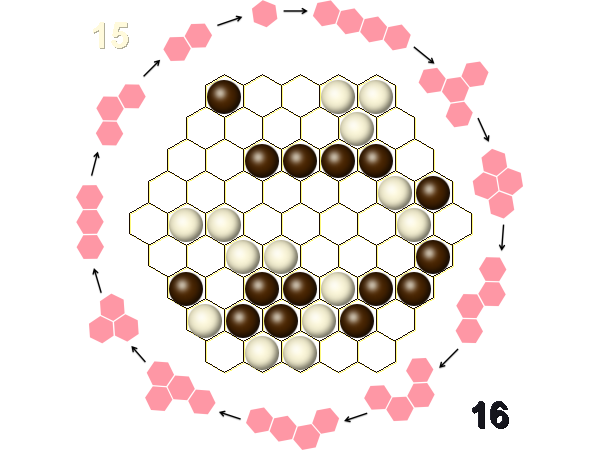 White to win in 5 moves | |
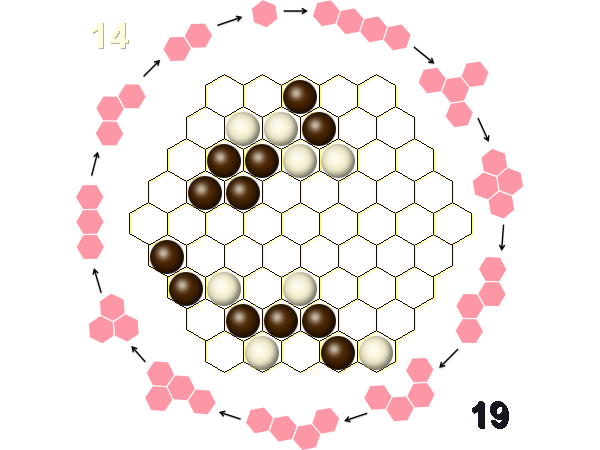 Black to win in 3 moves | |
 Black to win in 3 moves | |
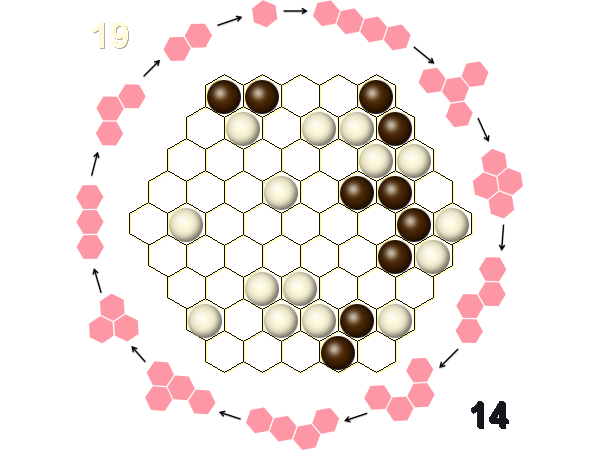 White to win in 3 moves | |
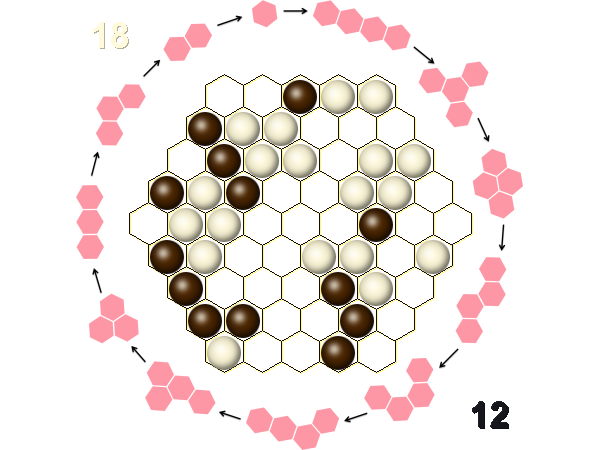 White to win in 3 moves |
Weak puzzle selection criteria are in place; the first move may not be unique.